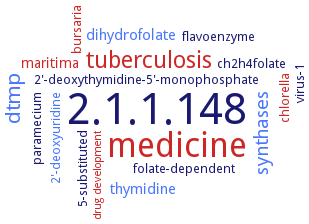2.1.1.148: thymidylate synthase (FAD)
This is an abbreviated version!
For detailed information about thymidylate synthase (FAD), go to the full flat file.

Word Map on EC 2.1.1.148 
-
2.1.1.148
-
medicine
-
tuberculosis
-
dtmp
-
synthases
-
thymidine
-
dihydrofolate
-
maritima
-
bursaria
-
2'-deoxyuridine
-
paramecium
-
folate-dependent
-
chlorella
-
5-substituted
-
virus-1
-
ch2h4folate
-
2'-deoxythymidine-5'-monophosphate
-
flavoenzyme
-
drug development
- 2.1.1.148
- medicine
- tuberculosis
- dtmp
- synthases
- thymidine
- dihydrofolate
- maritima
- bursaria
- 2'-deoxyuridine
-
paramecium
-
folate-dependent
- chlorella
-
5-substituted
-
virus-1
-
ch2h4folate
-
2'-deoxythymidine-5'-monophosphate
-
flavoenzyme
- drug development
Reaction
Synonyms
A674R, complementing thymidylate synthase, FDTS, flavin dependent thymidylate synthase, flavin-dependent thymidylate synthase, flavin-dependent thymidylate synthase X, flavin-dependent TS, Thy1, thymidylate synthase 1, thymidylate synthase complementing protein, thymidylate synthase ThyX, thymidylate synthase X, ThyX, thyX-encoded thymidylate synthase, TSCP, TTHA1096
ECTree
Advanced search results
Crystallization
Crystallization on EC 2.1.1.148 - thymidylate synthase (FAD)
Please wait a moment until all data is loaded. This message will disappear when all data is loaded.
hanging drop vapor diffusion method, using 0.2 M sodium chloride, 0.1 M MES, pH 6.0, and 20% (w/v) PEG2000 monomethyl ether
by the sitting-drop vapor diffusion method, in the presence of the cofactor FAD and the substrate analog BrdUMP, at 2.0 A resolution
-
I65M/L175M double mutant in the presence of FAD and BrdUMP, by the sitting-drop vapor-diffusion method, to 2.0 A resolution
molecular docking of inhibitor 5-undecyloxymethyl-2'-deoxyuridine 5'-monophosphate. The inhibitor and substrate dUMP share the same binding mode
molecular modeling of the complex with inhibitor 5-undecyloxymethyl-2'-deoxyuridine 5'-monophosphate. Inhibitor contacts mainly with amino acid residues of subunits A and C. The hydrophobic substituent at the C-5 position of nucleic base occupies active site mainly due to lipophilic interactions. Several amino acids of the active site such as Arg95, Gln103, Arg107, Arg172, and Gln106 being involved in the interaction with natural substrate dUMP contribute for affinity due to hydrogen bonds
-
crystal structure of the ThyX protein complexed to its FAD cofactor and solved by molecular replacement, to 2.3 A resolution, crystals belong to the P21212 space group with predicted two molecules per asymmetric unit and a solvent content of 51%
Paramecium bursaria Chlorella virus-1
-
crystal structure shows certain small structural differences in the active site when compared with either bacterial FDTS
Paramecium bursaria Chlorella virus-1
-
mutant H53D, in complex with the methyl donor, CH2H4 folate. The substrate-binding loop can be stabilized in two conformations and this affects the binding of the molecules at the substrate binding site. The isoalloxazine (flavin) ring of FAD binds in a big pocket that tolerates large movements of the isoalloxazine ring. The isoalloxazine ring is able to rotate in the binding pocket and utilize same face of the ring to bind to substrate and cofactors
mutants S88A and S88C, to 1.95 and 2.05 A resolution, respectively. Structure reveals minimlas changes in folding and active site conformation compared to wild-type. There is no covalent bond between the cysteine and dUMP in the crystal
structure of ThyX in complex with nonsubstrate analog inhibitor (2R)-2-[(3,5-dioxo-2,3,4,5-tetrahydro-1,2,4-triazin-6-yl)sulfanyl]propanoic acid
structure in complex with FAD and phosphate at 2.5 A resolution. Thy1 is a tetrameric molecule, to which four FAD molecules are bound. In the crystal, two phosphate ions are bound to each dUMP-binding site. There is an extra C-terminal domain consisting of three alpha-helices and a beta-strand


 results (
results ( results (
results ( top
top





